Are Small Dogs More Aggressive Than Large Dogs?
The answer is not so cut-and-dry. Here’s a deep dive into small-dog behavior.
The answer is not so cut-and-dry. Here’s a deep dive into small-dog behavior.
by Mia Nguyen, CPDT-KA, FFCP, | April 1, 2025

Andreas Schnabl / Pexels
Are you considering adopting a small dog? Maybe you’ve heard small dogs have big personalities packed into tiny bodies. Small dogs tend to have a reputation for being feisty, but are small dogs really more aggressive than big ones? Or is this just an unfair stereotype? Let’s break it down.
Dogs come in a wide variety of sizes, but the genes that determine size don’t inherently make them more or less aggressive. Below, we dig into the science of canine aggression, what really influences behavior (spoiler: size isn’t everything), and how training and socialization can help any dog — big or small — be their best self.
While it may seem that smaller dogs are more aggressive than large dogs, that’s actually not the case. There are many factors to consider, such as pet parents’ ability to spot signs of discomfort and stress in their dogs that could lead to aggressive behaviors, perceptions of aggressive behaviors specifically in small dogs, and more. It really boils down to a people problem.
Both pet parents and the general public have struggled to accurately read canine body language and identify pre-bite warning signs. On top of that, people with small dogs are more likely to see their pet’s aggressive behaviors as harmless or even “cute” because these behaviors are less likely to cause significant harm. This perception of small dogs as harmless leads to pet parents tolerating aggressive behaviors in small dogs with less of a desire to pursue training.
To support your small dogs’ emotional well-being, it is important to better understand body language and underlying emotional motives for aggressive behaviors.
Despite being more noticeable in large breed dogs, aggressive behaviors in small dogs look very similar. Although lunging, growling, and biting are often seen as aggression, small dogs often show subtler signs of nervousness or discomfort first.
Some of these signs include:
Appeasement licking
Whale eye
Lip licking
Turning their head away
A tight or wrinkled face
Ears pinned back
A hunched or curved posture
Yawning

Zkolra / AdobeStock
Many factors can influence a small dog’s aggressive tendencies.
The majority of small dog aggression comes from a place of fear. To make a scary thing go away, smaller dogs will bark, lunge, and growl to create distance. Defensive aggression (or fear-motivated aggression) is the most common type of aggression, and has been shown to take place in response to (or anticipation of) a scary event.

Does your dog cower or startle easily?
Although environmental and social factors play roles in canine aggression, genetics may also shape this behavior. Factors such as breed predisposition, heritability, gene-environment interaction, and hormones can all play a part in an increased risk of aggression. While genetics sets a baseline for behavior, upbringing, training, and socialization significantly shape aggressive tendencies (more on that, below).
If, for instance, a small dog was originally bred to rush, bite, bark, and chase, it is no surprise that you may be struggling with some reactivity and aggressive behaviors. These dogs are carrying out the behaviors they were bred to perform. To expect them to act any differently without guidance or training is simply unfair.
Dogs who have been attacked by another dog or mistreated by people sometimes develop aggression towards those who remind them of past abuse. In combination with genetics, early life trauma, poor socialization, and stressful living conditions can have lasting effects on a dog's behavior.
Parenting styles from both mother dogs and human pet parents will impact a dog’s temperament and behavior as they mature into adulthood. Specifically, mother dogs’ maternal behaviors towards their pups are found to have direct impacts on those pups’ physical and social engagement as well as aggressive tendencies as they reach maturity and adulthood. Mother dogs who exhibited more maternal care (physical affection, licking/grooming, sniffing/nuzzling, etc.) had puppies who were more physically engaging, social, and less likely to demonstrate aggressive behaviors in adulthood.
Similarly, pet parenting styles also impact dog behavior. Dogs with authoritative pet parents (high expectations, high responsiveness) are more likely to be highly social, sensitive to social context, and more successful with problem-solving tasks, in contrast to dogs with authoritarian pet parents (high expectations, low responsiveness) and permissive pet parents (low expectations, low responsiveness).
Socialization and handling during a puppy’s socialization period (three to 14 weeks of age) can make a puppy more self-confident, secure, and predictable. Since behavioral challenges are the top reason dogs are relinquished, early training and socialization play a crucial role in saving the lives of countless dogs.
Training and reinforcement histories play major roles in either mitigating or exacerbating aggressive behaviors in dogs. Positive reinforcement training (or giving the dog something they like, such as a treat, when they do something “good”) strengthens desired behaviors, builds trust, and helps dogs learn appropriate ways to interact with the world.
On the other hand, inconsistent training, punishment-based methods, and reinforcing aggressive responses can escalate aggression, particularly if the dog learns that aggression is an effective strategy to avoid unpleasant situations. Proper training, consistent reinforcement, and early socialization are key to reducing the likelihood of aggressive behavior and promoting a well-adjusted, confident dog.

Some dogs just need a bit of training and encouragement to help them overcome undesired behaviors.
Age definitely impacts a dog’s likelihood of aggressive tendencies. As dogs get older, they become less social. Like people, senior dogs may become more selective about their friends. Additionally, as your dog ages, they are also more likely to have aches and pains, which could make them more grumpy and less tolerant of triggers.
Being small makes everything in the world seem so big. And realistically, everything has a higher potential to hurt them. Smaller dogs are more likely to get stepped on, trampled over, and picked up. Because fear is the leading cause of aggression in dogs, small dogs, who already have more to fear, have more potential for fear-based aggression.
Spaying or neutering can potentially reduce aggression in small dogs, especially if the aggression is hormonally driven — but these are not guaranteed solutions. Because not all aggression in dogs is caused by hormones (such as fear-based aggression), it is best to consult your veterinarian.

alexzizu / Adobe Stock
The best way to prevent dog aggression in any breed, no matter their size, is to start socialization and training as early as possible. Preventing and managing dog aggression is a process that requires consistency, patience, and a combination of proper socialization and positive reinforcement.
If your dog displays aggressive behaviors, here are the best things you can do.
Determine what triggers their aggressive behaviors.
Properly manage triggers early to prevent a reaction.
Provide adequate and appropriate mental and physical stimulation.
Seek out the help of a professional trainer who’s skilled in behavior modification.
By focusing on positive, reward-based training and understanding the factors that influence aggressive behavior, you can help your small dog become well-adjusted, confident, and less likely to exhibit aggression.
Small dogs tend to show more aggressive and reactive behaviors because their stress and discomfort signals are often overlooked or not taken seriously by pet parents. Some small dogs start out reactive towards other dogs or people and, when not taken seriously, display more aggressive behaviors. This is why it is so important to listen to our dogs.
Despite the popular belief that dogs are defensive of their people, most dogs are actually responding to the environment from a place of fear or anxiety rather than a protective instinct toward their pet parent. Additionally, dominance theory, which has been historically linked to explanations of protective aggression, has been largely debunked in modern canine behavioral science.
Yes, training can lessen or even eliminate aggressive tendencies. Dogs are sentient beings with their own experiences and feelings, so there is never a guarantee. But working with the right trainer can be life-changing for both you and your dog.
Some small dogs bark more than large dogs because they’ve got a lot to say. While barking is often viewed as an obnoxious behavior, it’s their way of communicating — and you should listen. Because small-dog pet parents are less likely to seek out professional dog training and address their dogs’ problem behaviors, barking is often more prevalent in small dogs.
The best way to address aggression towards strangers is to figure out why your dog is behaving the way they are, and what purpose that behavior serves. How you address their concerns and modify the undesired behavior is best done with the help of a certified, positive reinforcement trainer. Remember, dog training is an unregulated field, so look for certifications such as CPDT, IAABC, and Fear Free.
Adkins, Erin, Nicole Fitzgerald, and Lauren Skaleske. “Puppy Socialization.” UC Davis Veterinary Medicine Animal Health Topics, April 10, 2019. https://www.vetmed.ucdavis.edu/sites/g/files/dgvnsk491/files/inline-files/Puppy_Socialization.pdf.
Arhant, Christine, Hermann Bubna-Littitz, Angela Bartels, Andreas Futschik, and Josef Troxler. “Behaviour of Smaller and Larger Dogs: Effects of Training Methods, Inconsistency of Owner Behaviour and Level of Engagement in Activities with the Dog.” Applied Animal Behaviour Science, March 2010. https://www.sciencedirect.com/science/article/abs/pii/S0168159110000262.
Bradshaw, John W.S., Emily J Blackwell, and Rachel A Casey. “Explore Scientific, Technical, and Medical Research on ScienceDirect.” ScienceDirect.com | Science, health and medical journals, full text articles and books., 2009. https://www.sciencedirect.com.
Brubaker, Lauren, and Monique A. R. Udell. “Does Pet Parenting Style Predict the Social and Problem-Solving Behavior of Pet Dogs (Canis Lupus Familiaris)? - Animal Cognition.” SpringerLink, September 30, 2022. https://link.springer.com/article/10.1007/s10071-022-01694-6.
Chopik, William J, and Jonathan R Weaver. “Old Dog, New Tricks: Age Differences in Dog Personality Traits, Associations with Human Personality Traits, and Links to Important Outcomes.” Journal of Research in Personality, April 2019. https://www.sciencedirect.com/science/article/abs/pii/S0092656618301661.
Demirbas, Yasemin Salgirli, Hakan Ozturk, Bahri Emre, Mustafa Kockaya, Tarkan Ozvardar, and Alison Scott. “Adults’ Ability to Interpret Canine Body Language during a Dog–Child Interaction: Anthrozoös: Vol 29, No 4.” Taylor & Francis Online, November 22, 2016. https://www.tandfonline.com/doi/abs/10.1080/08927936.2016.1228750.
Foyer, Pernilla, Erik Wilsson, and Per Jensen. “Levels of Maternal Care in Dogs Affect Adult Offspring Temperament.” Nature News, January 13, 2016. https://www.nature.com/articles/srep19253.
Miller, Pat. “Does Neutering Change Dog Behavior?” Whole Dog Journal, September 29, 2022. https://www.whole-dog-journal.com/behavior/does-spaying-or-neutering-change-dog-behavior.
Nelson, Randy Joe. Biology of aggression. Oxford: Oxford University Press, 2006.
Riemer, Stefanie, Carmen Heritier, Ines Windschnurer, Lydia Pratsch, Christine Arhant, and Nadja Affenzeller. “A Review on Mitigating Fear and Aggression in Dogs and Cats in a Veterinary Setting.” Animals : an open access journal from MDPI, January 12, 2021. https://pmc.ncbi.nlm.nih.gov/articles/PMC7826566.
Todd, Zazie. “Understanding Aggression in Dogs: It’s Complex, but Fear Is a Common Cause.” The American Veterinary Society of Animal Behavior, July 5, 2021. https://avsab.org/understanding-aggression-in-dogs-its-complex-but-fear-is-a-common-cause.
Walsh, Elizabeth Ann, Lieve Lucia Meers, William Ellery Samuels, Dorien Boonen, Anita Claus, Carolina Duarte-Gan, Vicky Stevens, Laura Contalbrigo, and Simona Normando. “Human-Dog Communication: How Body Language and Non-Verbal Cues Are Key to Clarity in Dog Directed Play, Petting and Hugging Behaviour by Humans.” Applied Animal Behaviour Science, March 2024. https://www.sciencedirect.com/science/article/abs/pii/S0168159124000546.
Wormald, Dennis, Andrew J Lawrence, Gabrielle Carter, and Andrew D Fisher. “Analysis of Correlations between Early Social Exposure and Reported Aggression in the Dog.” Journal of Veterinary Behavior, 2016. https://www.sciencedirect.com/science/article/abs/pii/S1558787816301411.
Ziv, Gal. “The Effects of Using Aversive Training Methods in Dogs-A Review.” Journal of Veterinary Behavior, 2017. https://www.sciencedirect.com/science/article/abs/pii/S1558787817300357.

Mia is a Certified Professional Dog Trainer and Behavior Consultant with a deep passion for helping dogs and their families build positive, lasting relationships. As the owner and trainer of Ace’s Pace based out of Sacramento, CA, she focuses on fear-free, science-backed techniques to guide pet parents through the nuances of dog behavior, training, and enrichment. Through a gentle, positive approach rooted in understanding and trust, Mia strives to help every dog live their best life, with the support and guidance that pet parents need to be successful. You can follow Mia and her life with dogs on Instagram at aces.pace.sacramento.

Breed Info
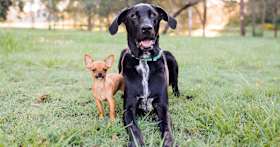
Breed Info
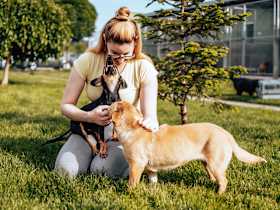
Shelters & Rescue
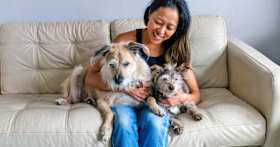
Breed Info
Are you a snuggler? If you’re looking for a lap dog, here are some go-to breeds.
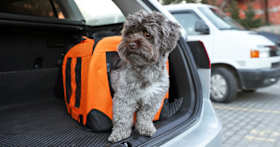
Adoption Advice
If you haven’t yet discovered, all dog carriers are not created equally. Our guide will help you find the right one for your pup.
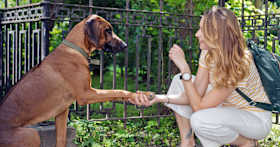
Adoption Advice
Find out why big dogs are basically the ultimate pets. We lay it out for you here.

Breed Info
Pedigreed pups are tied with mixed breeds for some disorders — but mutts reign supreme.

Adoption Advice
Lower healthcare costs, unique looks, adorable personalities — there are several reasons to rescue a mixed-breed dog. Here’s why you’ll fall in love with them.

Behavior & Training
Not all people are receptive to a dog showering them with attention by jumping on them. Here’s how to encourage your dog to curb this instinct, without losing their playful spirit.

Behavior & Training
If your dog won’t stop barking, don’t despair. There are several steps you can take to train your dog to quiet down.
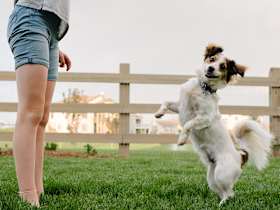
Adoption Advice
Learn the many benefits of adopting a shelter dog, and why giving a dog a second chance at a home is truly rewarding.

Adoption Advice
New rescue dog? Don’t panic — here’s your survival guide for the first few days and how to connect with your new best friend.